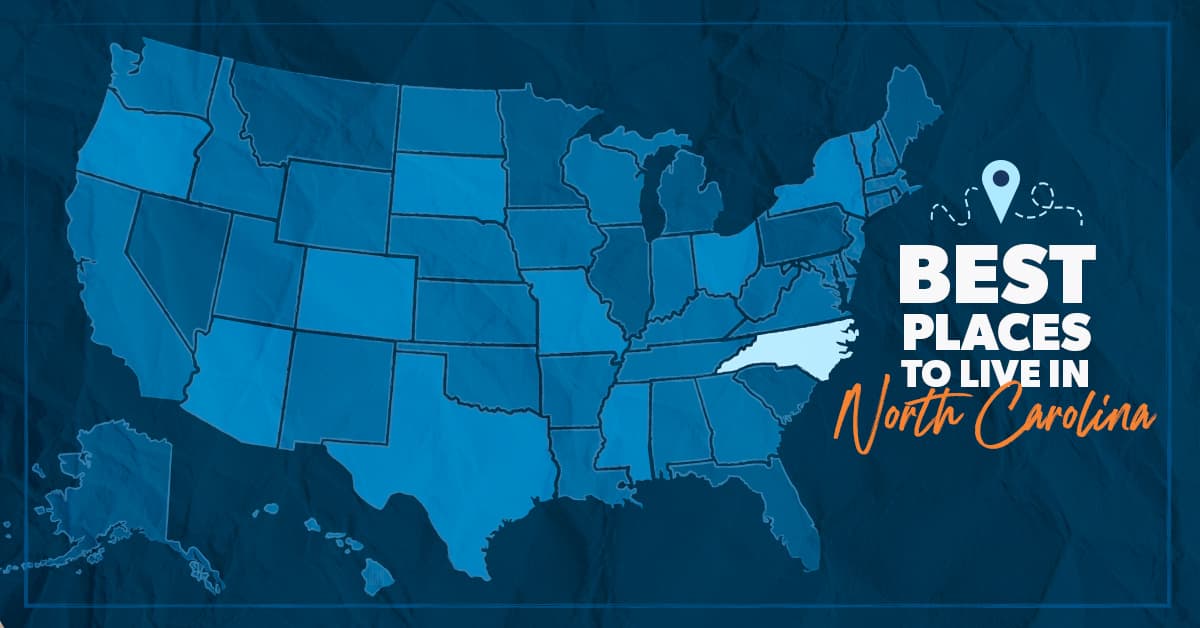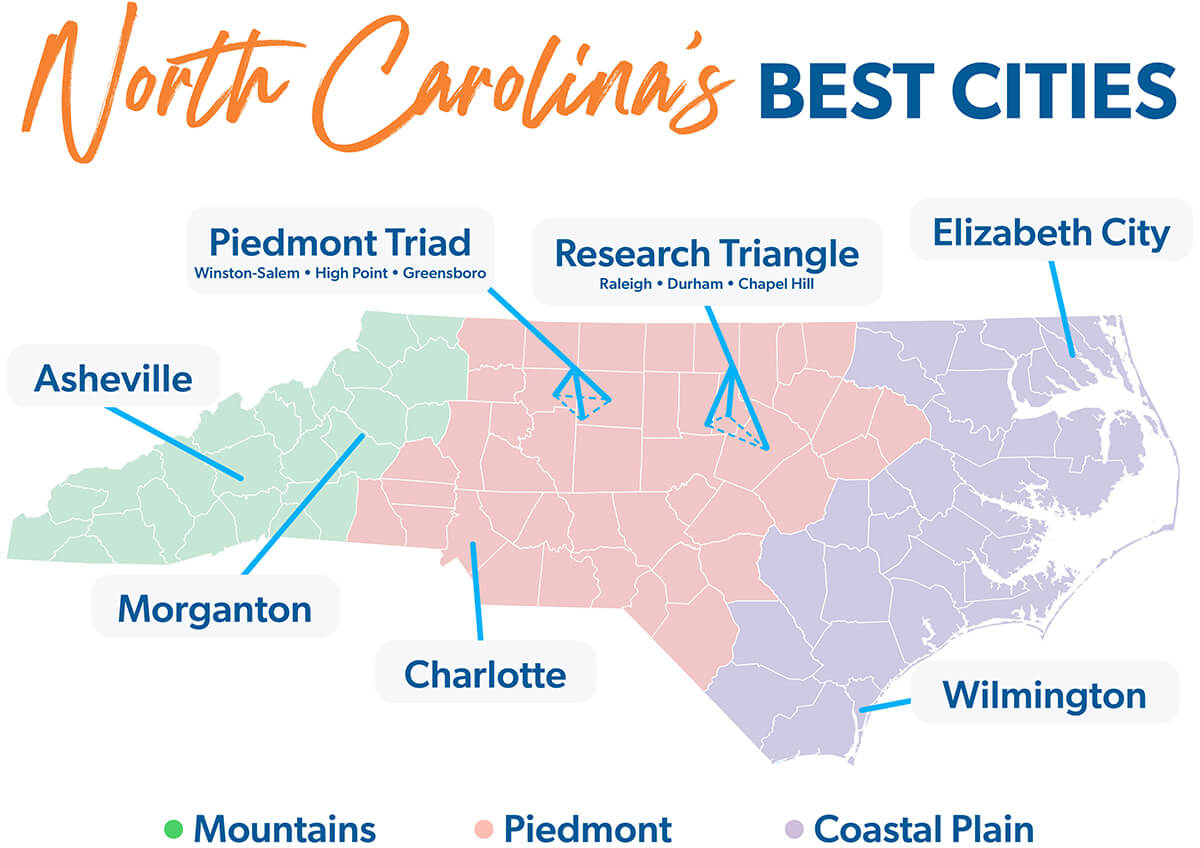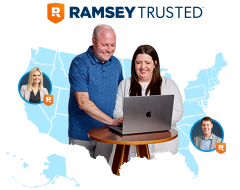
Key Takeaways
- From vibrant cities like Raleigh and Charlotte to scenic mountain towns like Asheville and Morganton, North Carolina offers a mix of urban and outdoor lifestyles.
- Cities like Winston-Salem in the Piedmont Triad provide lower home prices and cost of living compared to other major metro areas.
- The Research Triangle (Raleigh, Durham and Chapel Hill) is a hub for tech and scientific research, but the housing prices are much higher.
Want exciting cities, down-home vibes and super cool jobs? Head to North Carolina!
This state is hoppin’. It’s got old-fashioned Southern charm and modern business sense. And with its sports teams, historic sites, art scene and foodie culture (mmm, barbecue), the Old North State has something for everyone.
Whether you want to live in a cutting-edge city or settle down in a small town to raise your family, we’ll show you some of the best places to live in North Carolina.
A Look at North Carolina

North Carolina is a state that can accommodate many tastes and lifestyles. It’s got three unique regions: the Mountains, the Coastal Plain and the Piedmont—each with its own geographic and cultural character. So, whether you love the beach, enjoy fresh mountain air, or prefer someplace in between (literally), you can narrow down your search pretty easily.
But first, let’s clear something up: While we’ve used some hard data for our list (population, median income, housing prices, etc.), what makes a city the best place to live depends on what you are personally looking for. So be sure to think about what you need and want in a new city before you move.
Best Places to Live in the Mountain Region
The westernmost part of North Carolina bumps up against some of the most beautiful territory in the country: the Appalachians and their “kids,” the Blue Ridge and Great Smoky Mountains.
As you can probably imagine, the Mountain region offers a quieter, slower pace of life in addition to its scenic wonders. Outdoor enthusiasts will find no shortage of hiking and biking trails, ski areas, rafting runs and more. In fact, Great Smoky Mountains National Park, the most visited national park in the U.S., straddles the North Carolina/Tennessee border and is a major tourist draw to the area.1
However, this region was hit pretty hard by Hurricane Helene in 2024 and is still recovering. While some of the outdoor areas have reopened, many roads, highways, parks and trails remain closed as the mess is cleaned up.
Asheville
Known as The Land of the Sky, Asheville sits high up in the Blue Ridge Mountains and is a major tourist center for the Mountain region’s amazing outdoor spaces. In fact, tourism is the area’s main industry, followed by health care, education and manufacturing.2 Asheville has recently become a haven for remote workers and freelancers looking for a change from big-city life. Retirees have also been flocking to Asheville, which is why we named it one of our top cities for retirement.
The area’s ties to Appalachian culture are strong, with festivals dedicated to bluegrass music and Scotch-Irish heritage. Ashevillians also love their food, supporting local food vendors, farmers markets and farm-to-table restaurants and hosting food-themed events like the WNC Garlic Fest and Asheville Bread Festival. The city has even won the title of Beer City USA, with more than 100-plus craft breweries to explore (just not all at once).
|
Metro Area Population* |
417,2023 |
|
Median Annual Household Income |
$67,2214 |
|
Median Home Price |
$599,0005 |
|
Median Monthly Rent** |
$1,2886 |
|
Average Annual Rainfall |
46”7 |
*Unless otherwise noted, metro area population numbers include the city and the surrounding urban and suburban areas.
**“Median Monthly Rent” refers to two-bedroom apartments.
Morganton
Just east of Asheville on I-40, Morganton shares the Land of the Sky’s slower pace of life—but it’s a smaller town and not as dependent on tourism (government, manufacturing and health care are among the city’s top industries).8 While Morganton is in the Mountain region, it’s not technically a “mountain town,” since it sits in the foothills.
Find expert agents to help you buy or sell a home.
Morganton shares Asheville’s long history, going back to the 1700s. Many of the buildings in the city’s downtown have been lovingly restored, preserved and repurposed into apartments and one-of-a-kind shops. Downtown is the setting for many community events like the Historic Morganton Festival and the TGIF Concert Series—both of which are free! The nearby Apple Hill Orchard and Cider Mill is another popular place with the locals, offering bakery treats, apple picking and special events throughout the year.
|
Metro Area Population |
370,0309 |
|
Median Annual Household Income |
$49,43410 |
|
Median Home Price |
$370,00011 |
|
Median Monthly Rent |
$87112 |
|
Average Annual Rainfall |
47”13 |
Don’t buy or sell without an agent you can trust.
There are RamseyTrusted® real estate agents all over the country who are ready to help you win.
Best Places to Live in the Piedmont Region
The middle of North Carolina is known as the Piedmont—which is from a French phrase meaning “foot of the mountain.” It’s the middle ground between the mountains and the coast and is the most urban area of North Carolina. A majority of the state’s population lives in this region, as it contains two of the state’s largest industrial centers.
Research Triangle: Raleigh, Durham and Chapel Hill
The cities of Raleigh, Durham and Chapel Hill make up the three points of North Carolina’s Research Triangle—a booming hub for STEM. The area surrounds Research Triangle Park (RTP), which is the largest research community in North America and home to thousands of tech, biotech and medical companies.14 Big players like IBM, GE, Google, Meta and Apple have a presence there. The Triangle is also anchored by three famous research universities and five more colleges, giving the region a youthful vibe—not to mention a steady stream of fresh talent for those companies.
This means lots of well-paying STEM jobs are available in the area, no matter which city (or suburb) you choose. And there seems to be no stopping the Triangle’s business boom—especially since North Carolina is set to reduce its already low corporate income tax to zero (yes, zero) by 2030.15
These three major cities each have their own unique charms (not to mention the biggest college basketball rivalry in the country: Duke University vs. UNC-Chapel Hill). Let’s briefly go over each one:
Raleigh, the state capital, is the largest city in the Triangle—and it definitely has the most city vibe of them all. You can get dinner with friends, hit up a local gallery, and then hop over to a music festival for some rock, bluegrass or even opera. You can also catch a Carolina Hurricanes hockey game or check out the local museums (that’ll take a while—there are tons). Raleigh’s major university is North Carolina State, so there’s plenty of college-town energy too.
Durham is the second point in the Triangle, and its biggest employers are banks and medical companies. It’s the home of Duke University, and much of the city’s medical system belongs to the college. Duke also runs family-friendly nature centers like Duke Forest and Duke Lemur Center. Events like the Bull City Food & Beer Experience, Bull City Rumble motorcycle rally, and a variety of art, film and holiday festivals make this college town a place that never stops humming.
Chapel Hill is the smallest of the three points and is dominated by the University of North Carolina at Chapel Hill. In fact, the student body makes up over half of the city’s population!16,17 But the lively student presence doesn’t take away from Chapel Hill’s small, hometown feel, which many residents love. It does, however, keep the downtown area at Franklin Street hopping with activity. And like the other cities, Chapel Hill also boasts lots of historic sites and natural beauty (though it does lack many of the typical big-box stores).
|
Area Population* |
2.4 million17 |
|
Median Annual Household Income |
$89,18819 |
|
Median Home Price |
$377,50020 |
|
Median Monthly Rent |
$1,38921 |
|
Average Annual Rainfall |
47”22 |
*Area covered is the Raleigh-Durham-Cary combined statistical area, which includes the Research Triangle and surrounding communities.
Piedmont Triad: Winston-Salem, High Point and Greensboro
North Carolina has not just one but two triangle-shaped industrial centers. The Piedmont Triad, located to the west of the Research Triangle, is anchored by the cities of Winston-Salem, High Point and Greensboro. Like its sister area, the Triad was historically a hub for tobacco, furniture and textiles, but it now serves industries like biotech, aerospace and transportation.23 Furniture and textiles still have a presence though (Hanes is based in Winston-Salem, for example).
Let’s see what makes these three anchor cities special:
Winston-Salem started as two separate towns in the 1700s and 1800s that later merged in the 1900s. Today, the city is home to sites like the West End Historic District and Historic Bethabara Park, as well as museums—like its children’s museum and the Winston Cup Museum (we see you, NASCAR fans). And Winston-Salem is located in the western Piedmont . . . so close to those beautiful Carolina mountains.
High Point’s motto is “Make yourself at home” . . . which may be why the city has over 100 furniture stores! (Fun fact: It’s also home to the world’s largest chest of drawers.)24 Like most North Carolinians, the people of High Point love food and sports. You can enjoy local restaurants—including some dog-friendly ones—and catch a minor league baseball game (go, Rockers!). Or you can tour the city’s museums to learn about its history with jazz and the Underground Railroad.
Greensboro, the Triad’s third point, has a lot of history within its borders—from the American Revolution to the Civil Rights Movement. Today, it’s best known as Tournament Town because of its wealth of quality sports venues, which have hosted competitions like the ACC Basketball Tournament, the U.S. Figure Skating Championship, and the PGA Wyndham Championship. Greensboro also lives up to its name with lots of parks, nearby lakes and rivers, and other green spaces to explore—including the historic Guilford Courthouse National Military Park.
|
Area Population* |
1.7 million25 |
|
Median Annual Household Income |
$63,81226 |
|
Median Home Price |
$290,00027 |
|
Median Monthly Rent** |
$1,014–1,05828 |
|
Average Annual Rainfall |
44”29 |
*Area covered is the Greensboro–Winston-Salem–High Point combined statistical area, which includes the Piedmont Triad and surrounding communities.
**Range based on medians in Winston-Salem and Greensboro-High Point metro areas.
Charlotte
Hugging the border of South Carolina is the Queen City of Charlotte. Founded in 1768, the city was named after the wife of King George III of England (you know, the guy America wanted to break up with back in 1776)—and it’s just as classy as its namesake. Charlotte has stunning natural scenery, like Lake Norman, and vibrant neighborhoods along with its modern skyline. Just don’t confuse Downtown and Uptown—it makes the locals mad.
Now, don’t let Charlotte’s old-world charm fool you! The biggest city on our list is home to 18 companies on the Fortune 1000 list—many of them in the finance, tech and manufacturing industries.30,31 Charlotte’s also got a killer craft beer scene to go with its pro sports teams: the Carolina Panthers (NFL) and Charlotte Hornets (NBA).
Not into organized sports? The U.S. National Whitewater Center is in Charlotte—and it doesn’t get any less organized than zipping down a river in a rubber raft! And if you’re craving some land-based thrills, check out Carowinds amusement park and its 13 roller coasters.
|
Metro Area Population |
2.8 million32 |
|
Median Annual Household Income |
$78,43833 |
|
Median Home Price |
$450,00034 |
|
Median Monthly Rent |
$1,40835 |
|
Average Annual Rainfall |
43”36 |
Best Places to Live in the Coastal Plain Region
If the mountains or large urban centers aren’t your thing, you can always head for the Coastal Plain to be near the sea breezes and beaches. The North Carolina coast is lined with enough bays, rivers, sounds and inlets to keep any water enthusiast (not to mention geographers) busy. The northern portion is also protected by the Outer Banks, a string of barrier islands. Visit them and you just might see some wild horses!
Fun fact: The Outer Banks, specifically Kitty Hawk, is where the Wright Brothers made the first powered flight back in 1903. Maybe the Coastal Plain is where you’ll have your own great adventure!
Wilmington
Located on the southern coast of North Carolina, Wilmington is a seaside city that blends old-world charm and new-world industry. Wilmington is a center for distribution, pharmaceuticals, food processing, manufacturing and aviation (continuing the Wright brothers’ tradition).37 The city is also known as Hollywood East or Wilmywood because of all the movie and TV production taking place there. Past shows and films have included favorites like Dawson’s Creek, The Conjuring and Iron Man 3.
On the history side, Wilmington has several colonial sites and historic districts to explore. World War II buffs can climb aboard the USS North Carolina battleship. Or for a more modern experience, visit the aquarium, beach boardwalks and locally owned shops and restaurants. The city also boasts the Cape Fear Riverwalk—so you can enjoy the water while keeping dry land under your feet.
The downside to beachside living is you’ll pay beachside prices. Wilmington has the second-most expensive homes on our list—and the third-lowest income. If you’re thinking of moving here, figure out exactly how much house you can afford before you take the plunge. Oh, and pack a raincoat—Wilmington is the rainiest city on our list!
|
Metro Area Population |
467,33738 |
|
Median Annual Household Income |
$63,90039 |
|
Median Home Price |
$500,00040 |
|
Median Monthly Rent |
$1,29541 |
|
Average Annual Rainfall |
55”42 |
Elizabeth City
Inland along the Pasquotank River, about 17 miles from the coast of the Albemarle Sound, Elizabeth City is known as the Harbor of Hospitality thanks to its unique tradition of welcoming visiting boaters at Mariners’ Wharf with roses (and in later years, no docking fees and free Wi-Fi). That welcoming spirit can be felt throughout the city—from the active commercial district to public events like the North Carolina Potato Festival and the Mariners’ Wharf Film Festival. It’s also on display at the Museum of the Albemarle, where interactive exhibits showcase the region’s history.
Elizabeth City is also a military town, home to U.S. Coast Guard Base Elizabeth City—which is the country’s largest Coast Guard facility and the region’s largest employer. Aviation, education and health care are also major sectors.43 Many Elizabeth City residents work in the Norfolk and Virgina Beach areas in Virginia, which are about an hour away (Elizabeth City is technically part of the Norfolk metro area).
|
Metro Area Population |
1.8 million44 |
|
Median Annual Household Income |
$50,94745 |
|
Median Home Price |
$366,47546 |
|
Median Monthly Rent |
$1,60047 |
|
Average Annual Rainfall |
50”48 |
Best Suburbs in North Carolina
Not digging the city lifestyle but still want to stay connected to all those urban amenities? Here’s a list of some great suburbs of the cities we mentioned that not only offer a more peaceful lifestyle but are also great places to raise a family.
Apex (Raleigh)
Carrboro (Durham)
Cary (Raleigh)
Davidson (Charlotte)
Harrisburg (Charlotte)
Summerfield (Greensboro)
Ready to Move to North Carolina?
Whether you’re moving from another state or already call North Carolina home and are just switching towns, you need an expert real estate agent to help you make the move. We recommend partnering with a RamseyTrusted® agent.
These top-performing real estate agents can help you find the best place to live in North Carolina. From choosing the right neighborhood for your family to picking the perfect house (or selling your old one), they’ll walk you through the whole process. And these guys and gals are RamseyTrusted—so they always put serving ahead of selling.
Next Steps
- Decide where in North Carolina you want to live.
- Interview at least three local agents we trust.
- Choose one who’s right for you and start your moving journey.
Did you find this article helpful? Share it!

We Hear You!
We’re considering adding the ability to save articles to your Ramsey account.




